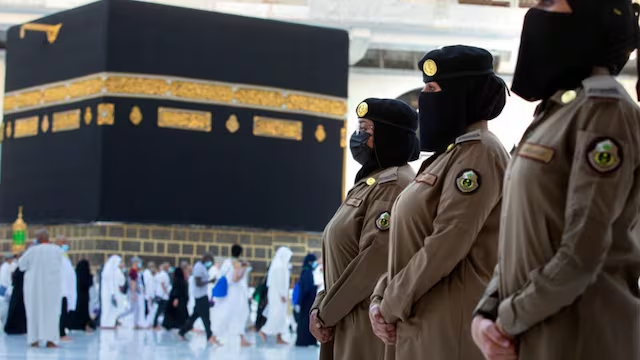As millions of Muslim pilgrims prepare for the Hajj pilgrimage, Saudi Arabia has unveiled a new initiative to ease their journey. Digital Hajj Guide the country has introduced a digital guidebook known as the “Smart Book of Hajj Rituals.” This guide, which provides important information about the rituals and practices of Hajj, is available in multiple languages. However, a surprising choice has emerged: while Malayalam is featured as one of the languages, Hindi – a widely spoken language in India – is notably absent.
The digital guide is an integral part of Saudi Arabia’s efforts to modernize and enhance the pilgrimage experience for the ever-growing number of pilgrims coming from all over the world. The guide is designed to offer valuable assistance to pilgrims, allowing them to navigate the various rites of Hajj with ease. It is available on the official Hajj website and will also be accessible on Saudia Airlines’ flights, which serve as the primary air travel provider for many pilgrims heading to Saudi Arabia.
Languages Included in the Smart Guide
The Hajj Smart Guide is available in six languages: Arabic, English, French, Turkish, Urdu, and Malayalam. These languages have been chosen based on their relevance to Muslim populations worldwide. Arabic is the official language of Saudi Arabia, while English and French are widely understood in many countries. Urdu is spoken by millions in Pakistan and parts of India, and Turkish caters to the large Turkish Muslim community.

However, the decision to feature Malayalam instead of Hindi has sparked debate. Hindi, one of the official languages of India and spoken by a vast majority of the Indian population, is absent from the list. This exclusion has raised concerns among Indian pilgrims who feel that their linguistic needs have been overlooked.
Malayalam, a language predominantly spoken in the Indian state of Kerala, has been chosen over Hindi, despite Hindi being the second-most spoken language in India and the mother tongue of many Muslim pilgrims who make the journey to Mecca each year. India has one of the largest Muslim populations globally, and Hindi is widely used in many Muslim-majority areas of the country.
Why Malayalam and Not Hindi?
The selection of Malayalam, while raising eyebrows, is seen as a strategic move. The Indian state of Kerala, where Malayalam is the primary language, has a significant Muslim population that participates in Hajj every year. Additionally, Kerala’s large community of Muslim pilgrims, combined with their active participation in Hajj, may have influenced this choice.
It is important to note that the number of Kerala-based Muslims making the pilgrimage is high, and this could explain why Saudi Arabia’s Hajj authorities prioritized Malayalam. However, this does not entirely justify the exclusion of Hindi, which could have been a more inclusive choice, given the diversity of Indian pilgrims who attend the annual event. Hindi is the primary language for millions of Indian Muslims, and many of them feel excluded by the absence of this language in the guide.
Reactions and Implications
The exclusion of Hindi has sparked conversations both within India and among the Indian diaspora worldwide. In 2024, over 78,000 Indian Muslims participated in Hajj, and this number is expected to rise in 2025. Given this significant number, many have raised questions about why a language spoken by such a large portion of the Indian Muslim community was left out.
The Indian government, through its Ministry of Minority Affairs, has been consistently working to improve the Hajj experience for Indian pilgrims. This includes the creation of the “Haj Suvidha” mobile app, which provides services in multiple languages, including Hindi, to assist pilgrims with logistics, healthcare, and other essential services during the pilgrimage. The Indian Haj Mission has also adopted digital platforms to facilitate communication, ensuring that pilgrims can easily access information and voice grievances in real-time.
The absence of Hindi in the Hajj Smart Guide has also led to some frustration among Indian Muslims, who feel that their linguistic needs are not being given the attention they deserve. While the government has been making efforts to bridge the gap through digital solutions, the fact that a language like Hindi – spoken by millions – is left out of an official guidebook raises concerns about accessibility and inclusivity.
Saudi Arabia’s Efforts to Enhance the Hajj Experience
Saudi Arabia has been taking significant steps to improve the overall experience for pilgrims, particularly as the Hajj pilgrimage continues to grow in scale. The kingdom has been embracing technology to provide better services, such as virtual guides, mobile apps, and other resources that help pilgrims navigate the sacred rituals and avoid confusion during their stay in Mecca.
In addition to the digital guide, Saudi Arabia has invested heavily in infrastructure projects that aim to improve the facilities available to pilgrims. The country has expanded the Grand Mosque in Mecca, built modern transportation systems like the Haramain high-speed railway, and improved healthcare services for pilgrims. These efforts show Saudi Arabia’s commitment to ensuring that the Hajj experience is smooth, safe, and memorable for millions of Muslims every year.
However, while the physical infrastructure may be improving, the digital divide and linguistic challenges remain. Despite the advancements, there is still room for improvement when it comes to making sure that all pilgrims, regardless of their linguistic background, have access to the resources they need. The exclusion of Hindi from the Hajj Smart Guide is a reminder that the diversity of the Muslim world should be reflected in such initiatives.
What’s Next for the Hajj Smart Guide?
As the 2025 Hajj season approaches, many are watching to see if Saudi Arabia will expand the language options in the Smart Book. It remains to be seen whether the Hajj authorities will recognize the concerns surrounding the omission of Hindi and take action to address this gap.
The inclusion of Malayalam is a positive step for the Malayali Muslim community, but it should not come at the expense of other communities. The decision could be viewed as a case of catering to specific regional needs rather than considering the broader, diverse needs of the global Muslim population.
In conclusion, while the Saudi initiative to offer a digital guide in multiple languages is commendable, the exclusion of Hindi raises questions about inclusivity. The Hajj pilgrimage is a deeply spiritual journey for Muslims, and ensuring that all pilgrims have access to essential information in their native language is a crucial part of making this experience more meaningful and accessible. As the digital era continues to shape how pilgrimages are experienced, it is vital that initiatives like these evolve to reflect the diversity of the Muslim community worldwide.



